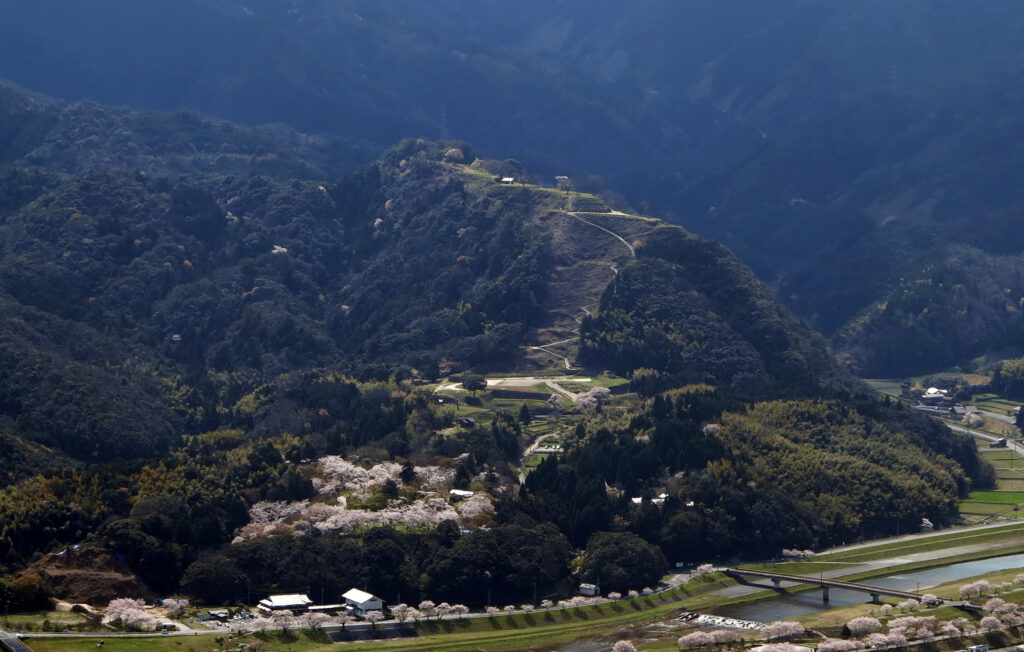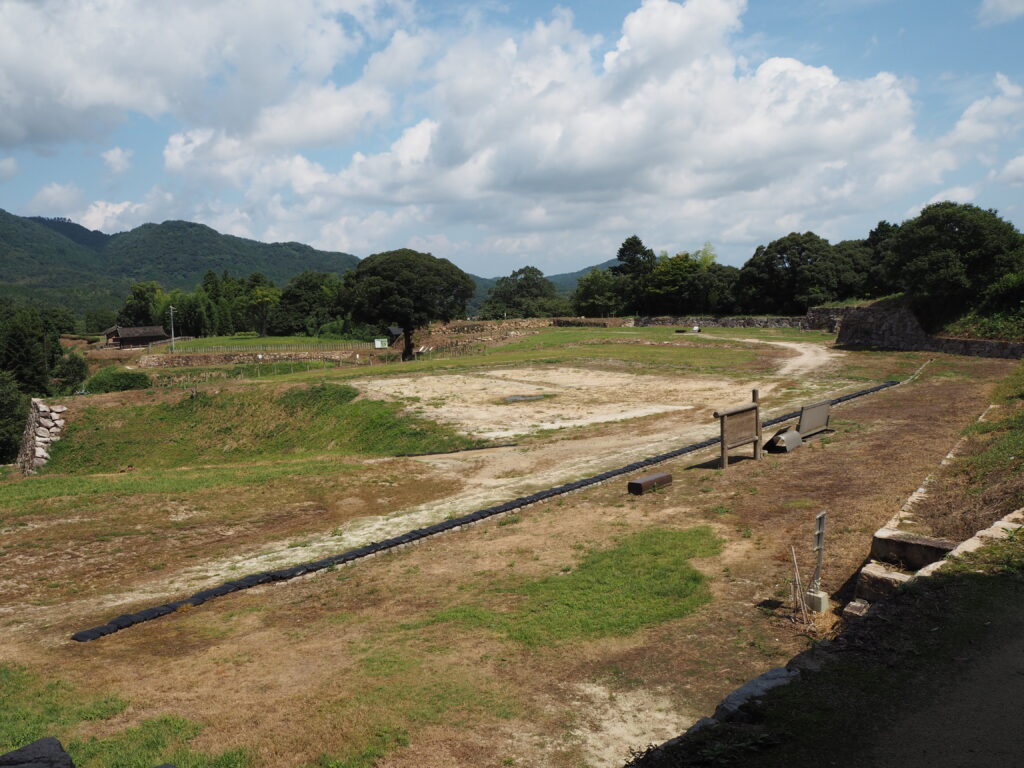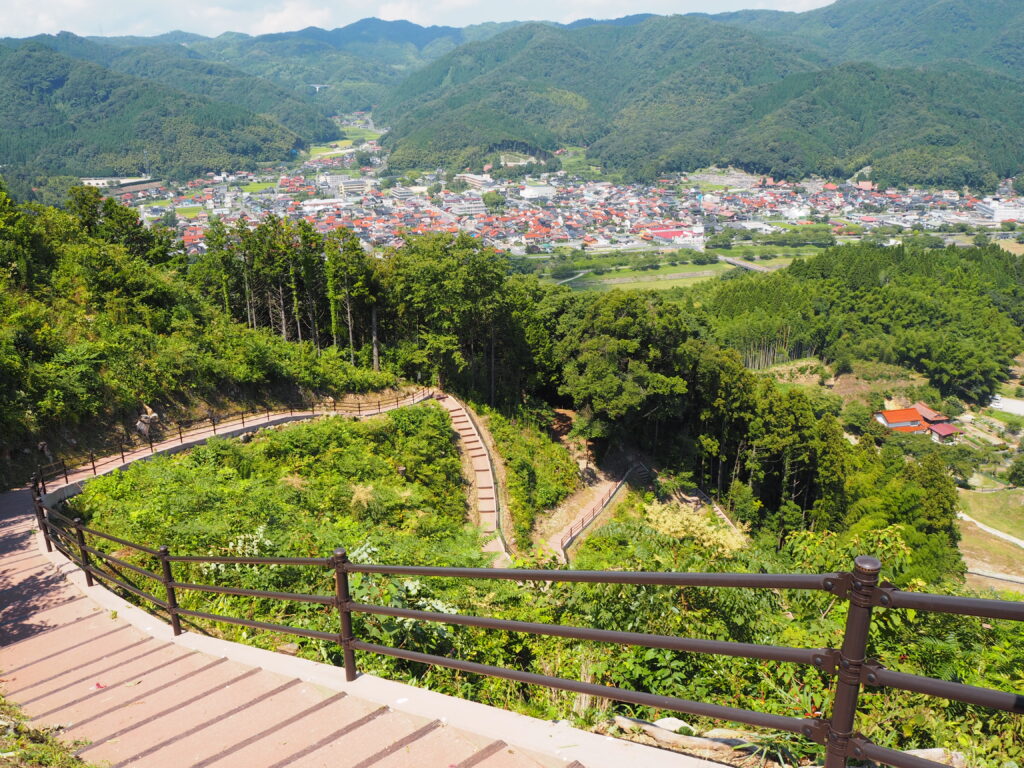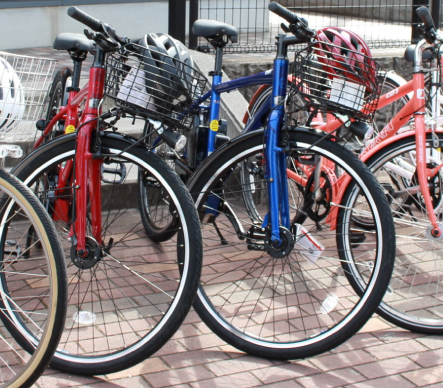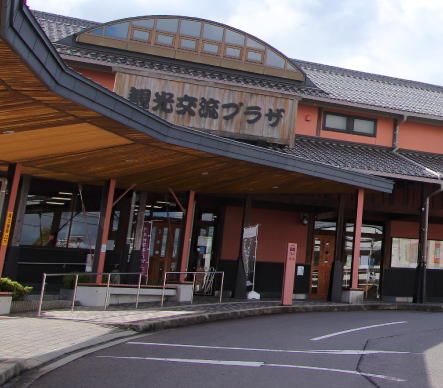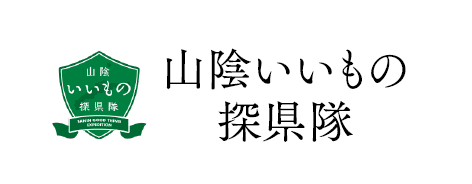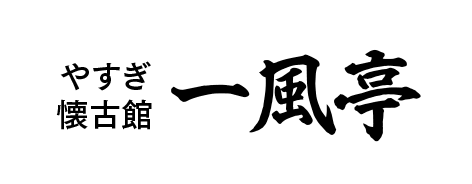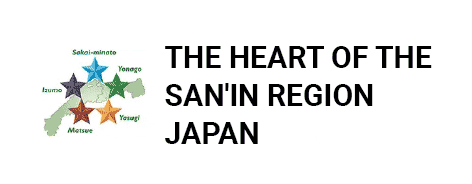Gassantoda Castle
Infomation
Tomita, Hirose-cho, Yasugi City, Shimane Prefecture
Yasugi City Historical Museum Opening hours: 9:30-17:00 Closed every Tuesday (or the following day if Tuesday is a public holiday)
*The 100 Famous Castles stamp can be obtained at the Yasugi City Historical Museum. It is placed in front of the entrance on closed days.
Impregnable castle
Gassan Toda Castle is a vast mountain castle that stretches in a horseshoe shape towards the Iinashi River, with Mt. Gassan at an altitude of 190m at its centre.It is a multi-walled mountain castle with the main bailey at the top of the mountain and numerous large and small baileys on the ridge, meaning it can only be attacked from three directions: Sugayaguchi, Mikomoriguchi, and Shioyaguchi.Even if the lower level of the castle’s inner bailey falls, it can be defended from the middle Yamanaka Goten, and even if that falls, it can be defended by climbing up the main mountain, Mt. Gassan, and a moat was built at the top to strengthen the defenses, making it an impregnable castle that has never fallen.
The Sengoku daimyo Amago clan used it as a base for governing the Sanin region, and after the Amago clan, the castle was passed down to the Mori clan, Yoshikawa clan, and Horio clan, and it was the political and economic center of Sanin from the Sengoku period to the beginning of the Edo period. After the Yoshikawa clan took over as lord of the castle, stone walls were built in key areas, and tiled turrets and earthen walls were added, dramatically transforming the castle from a medieval to a modern one, and it prospered as the center of Izumo Province until the Horio clan, who later took over as lord, built Matsue Castle and moved their base there.
In 1934, its historical value was recognized and it was designated as a national historic site, and in 2006 it was selected as one of Japan’s 100 most famous castles, and in 2018 it was also selected as a constituent cultural asset of the Japanese Heritage “Izumo no Kuni Tatara Fudoki.”
[Audio Guide] Impregnable Castle “Gassan Toda Castle” Conquest Tour
Spot introduction
Senjodaira
This is one of the enclosures closest to the castle town, and has a large stone wall with a protruding ledge built on the slope. A large number of tiles, including shachihoko tiles and oni tiles, have been excavated in the surrounding area, suggesting that a turret was once built on top of the protruding ledge.
Taiko altar
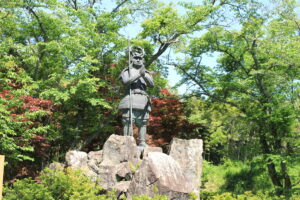
The Taikodan is said to be the site of a drum tower used to tell the time. During the Amago era, it was said to be a place where drums were beaten to tell the time, and in times of emergency, it was used to send signals to vassals and summon soldiers. Currently, a bronze statue of Yamanaka Kasuke Yukimori, who worked hard to restore the Amago clan, has been erected here.
Horse riding arena
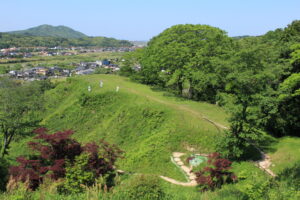
It is a long, narrow enclosure extending northwestward, 10 to 20 meters wide and about 140 meters long, and is said to have been used as a horse training facility.
Okushoin
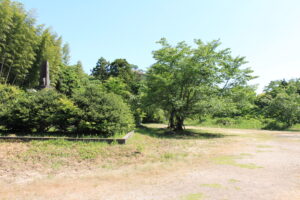
It is said that there was a shoin-zukuri building in the middle of the kuruwa between the taikonodan and the hananodan.
flower bed
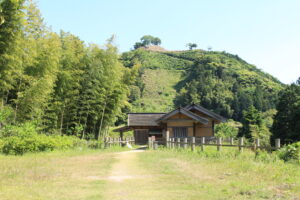
The remains of the former samurai residence, including a building with pillars and other structures, remain. Parts of the building have been restored and are open to the public as a rest facility.
Yamanaka Gotendaira
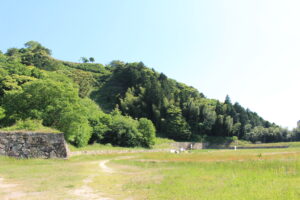
Located halfway up Mt. Gassan, this is believed to have been the castle lord’s residence, and was one of the most important areas within the castle. It is a vast enclosure surrounded by stone walls.
Oodorui
The large earthwork on the west side of Yamanaka Gotendaira is rare even in Japan, measuring approximately 7 meters high and 130 meters long. The dry moat outside of it is approximately 10 meters wide and over 5 meters deep. It is thought to have been built to prevent enemy invasions of Yamanaka Goten.
Nanamagari
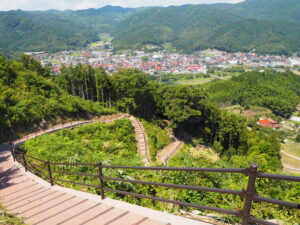
The steep path from Yamanaka Palace to the summit makes it impossible to advance if attacked from above. Attacks can also be made from the moats on either side of the path. Gassan Toda Castle has never been attacked all the way to the summit, so the seven bends symbolize Gassan Toda Castle’s impregnability.
Sannomaru
This is the first enclosure you come across after climbing the seven curves. It is about 30 meters wide and 100 meters long. It has stepped stone walls and is thought to date back to the Yoshikawa period.
Ninomaru
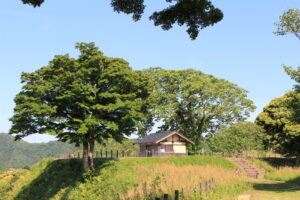
It is believed that water and food were stored there, and between the Ninomaru and Honmaru there is a moat that cuts through the baileys to prevent enemy attacks.
Honmaru
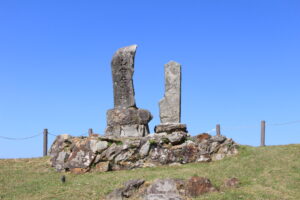
A monument has been erected in memory of Yamanaka Kasuke Yukimori, and at the back is Katsuhi Takamori Shrine, which is also mentioned in the Izumo Province Tatara Fudoki.
Glossary
①Kuruwa (Kuruwa) – the basic area for defense
An artificial flat area where buildings could be erected and moats could be created to enhance the effectiveness of defense. Arranging a number of kuruwa in a row cleverly prevented attackers. They were also places of living, and Gassan Toda Castle has a total of around 500 kuruwa.
② Kirigishi – Carved-out steep slope
The outside of the enclosure was carved out to make it steeper, making it difficult for attackers to climb and easier for defenders to attack from above. Though it was a simple design, it was highly effective in cutting off attacks from attackers. You can see these in various places around Gassan Toda Castle.
③Horikiri – A depression that separates the enclosures
Dry moats were built between the moats along the ridge. Because the moats were not connected, attacks had to be made in a roundabout way, which had the effect of cutting off attacks. Taking advantage of the natural terrain, the defenses were strengthened by placing multiple moats and moats.
④ Vertical moat – a moat dug at right angles to the contour lines
By digging a trench, the slope can be divided vertically, preventing the enemy from moving sideways.
⑤ Earthwork – A large wall made of earth
A large wall made of earth. The highlight of Gassan Toda Castle is the large earthwork rampart to the west of the Yamanaka Palace.
⑥ Ishigaki – A high, steep wall built with piled stones
From the Azuchi-Momoyama period through the Edo period, stone walls made of earth and stone were widely constructed, evolving from the earthen ramparts that had been used up until then. Building stone walls takes time and effort, but they are stronger and higher than earthen ramparts, and they also made it possible to build tiled buildings on top of them. The stone walls of Gassan Toda Castle are said to have been started by Yoshikawa Hiroie, who further improved them after returning from his expedition to Korea. It is also said that father and son Horio Tadauji and Yoshiharu, who entered the castle after the Battle of Sekigahara, continued to build the stone walls.
⑦ Koguchi (Tiger’s mouth) – the entrance to the enclosure, which is the key to defense
Entrances to the enclosures. As this is a key point in defense, various defensive measures have been put in place, such as gates, stone walls and turrets. Gassan Toda Castle has three entrances, all of which ultimately lead to the Yamanaka Palace. The entrance to the Yamanaka Palace from the Sugaya entrance is made of stone walls and curves at a right angle. The entrance to the Yamanaka Palace from the Shioya entrance is also made of stone walls, and is designed so that you cannot enter without bending left and right and climbing. Both of these were designed to allow enemies to attack from the front and sides, and to make it difficult for them to enter the Yamanaka Palace.
⑧ Yokoya – Attacking the attacker from the side
When an enemy attacks a bailey, they are attacked from the side rather than the front, which is called a yokoya. The enemy is lured into the valleys of the many hills, and then attacked from the top of the hills on both sides. Also, by placing the tiger’s mouth and walls at right angles, bending the passageways, and creating corners by extending part of the bailey, the defenders can attack from the side as well as the front. Yokoya can be seen at the tiger’s mouth, the corners of the riding arena, and the curved passageways of the flower terrace.
9. Yagura (turret) – a building used for attacking from a high place
Turrets were built at key points in the castle to allow for attacks from high places, and some were used to alert the enemy to upcoming attacks. The remains of turrets have been discovered in the moats that jut out to the east and west at the summit of Gassan Toda Castle, and they were used to not only monitor enemy movements but also to check smoke signals rising from surrounding castles and forts. At Senjodaira, there is a stone wall where a turret is thought to have been built, and shachihoko tiles that are thought to have been used in the building have been excavated.
10. Moat – Using water to prevent enemy invasion
There is a moat (water moat) surrounding Tomita Castle. The Iinashi River on the other side of the castle also served as a natural moat, and enemies attacking from the west over the mountains were blocked by the large river that stretched out before them. The Iinashi River is also thought to have played a major role in logistics. The current Iinashi River changed course during the Edo period, and during the Sengoku period it flowed further west to where the city is now.
Gassan Toda Castle Chronology
| Castle lord | era | Major events |
| Kiyosada Amago | 1467 | The Onin War broke out, and the flames of war spread throughout the country. |
| 1468 | Matsuda Bizennokami, lord of Togamiyama Castle in Yasugisho, invaded Tomitasho. | |
| 1476 | An uprising occurs in Nogi County, and rebels attack Tomita Castle. | |
| 1484 | Amago Kiyosada and Tsunehisa, father and son, are dismissed from their positions as shugodai. | |
| Shioji Kanbesuke | 1486 | Amago Tsunehisa defeats the guardian, Enya Kabenosuke, and recaptures Tomita Castle. |
| Amako Tsunehisa | 1530 | Amago Tsunehisa’s third son, Shioya Okihisa, rebelled due to a disagreement with his father and later committed suicide. |
| 1537 | Amago Tsunehisa passes on the family headship to his grandson Haruhisa | |
| 1540 | Amago Haruhisa attacks Mori Motonari at Yoshida-Koriyama Castle | |
| Haruhisa Amako | 1543 | Ouchi Yoshitaka attacks Izumo but is defeated and retreats. |
| 1552 | Amago Haruhisa is appointed guardian of eight provinces in San’in and San’yo. | |
| 1554 | Amago Haruhisa annihilated the Shingu clan, Kunihisa and Masahisa were killed, Takahisa was killed in battle, Tsunehisa and Yoshihisa committed suicide, and his grandson Katsuhisa escaped at the age of 2. | |
| 1556 | Amago Haruhisa seizes the Iwami Silver Mine. | |
| Yoshihisa Amago | 1565 | Mori Motonari attacks and besieges Tomita Castle |
| 1566 | Amago Yoshihisa runs out of food and surrenders to the Mori clan, surrendering Tomita Castle. | |
| Takashige Amano | 1567 | Takashige Amano’s castle |
| 1569 | The Amago restoration army led by Amago Katsuhisa and Yamanaka Shikasuke advances to Izumo. | |
| Motoaki Mouri | 1570 | The Amago army was defeated in the Battle of Nunobe and Yamasa, and Motoaki Mori became the lord of the castle. |
| 1578 | Kozuki Castle in Harima Province falls, Amago Katsuhisa commits suicide, and Kanosuke is assassinated in Bitchu. | |
| 1582 | The Honnoji Incident occurs | |
| Motoyasu Mouri | 1585 | Motoaki Mori dies of illness, and his younger brother Motoyasu becomes the castle owner. |
| 1590 | Toyotomi Hideyoshi unifies the country | |
| Hiroie Yoshikawa | 1591 | Yoshikawa Hiroie becomes the lord of the castle and begins construction of Yonago Castle. |
| 1592 | The Bunroku-Keicho War breaks out, and Hiroie also marches to Korea. | |
| Tadashi Horio | 1600 | After the Battle of Sekigahara, Yoshikawa Hiroie was replaced by Horio Tadauji, who entered the castle with his father Yoshiharu. |
| Yoshiharu Horio | 1604 | Tadashige suddenly passed away, and Yoshiharu returned to government affairs. |
| 1611 | Yoshiharu Horio moved his castle to Matsue Castle, and the castle was abandoned. |
Commentary on Gassan Toda Castle and the Amago Clan
The rise and fall of the Amago clan
What kind of family was the Sengoku daimyo “Amago clan” who ruled over the 11 provinces of San’in and Sanyo at their peak, centering on Gassan Toda Castle in Hirose Town, Yasugi City?
An easy-to-understand explanation of Amago Seisuiki
I will explain the Amago rise and fall in an easy-to-understand manner.
A place related to Shikanosuke Yamanaka
Yukimori Yamanaka Shikanosuke, a warlord of Yasugi City
Introducing the turbulent life of Yamanaka Shikanosuke Yukimori, a tragic Sengoku military commander with many hardships.
Kawanakajima Battle Monument
This is the place where it is said that Yamanaka Shikanosuke Yukimori and Natsuki Rosuke Katsumori fought one-on-one on Kawanakajima in the Tondagawa River.
Birthplace of ShikanosukeYukimori Yamanaka
There is a stone monument at the ruins of the Yamanaka mansion, which is said to be the birthplace of Shikanosuke Yamanaka.
Mount Mikasa
Shikanosuke Yamanaka is said to have worshiped the crescent moon hanging over Mt.
Document download
・Please see here for bus times to Gassan Toda Castle Ruins.
・“Gassan Toda Castle Ruins Contour Map” can be downloaded from here.
*To climb Katsuyama Castle, located across from Gassan Toda Castle, please start from Higashiizumo-cho, Matsue City.
Restaurants near Gassan Toda Castle Ruins
★Just a short walk away
Amago Soba and Udon Shop (inside Hirose Kasuri Center)
★About 10 to 15 minutes on foot
Kawanishiya , Cafe Sakura , Umaimonya Mitchantei , Cafe & Kitchen Suzukaze
*Please call each facility for information on closing days and reservations.
MAP
Share
Please follow!
Related spot
-
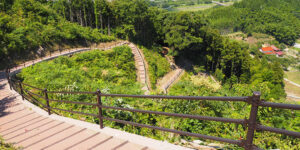
Nanamagari
Address〒692-0403
Tomita, Hirose Town, Yasugi City, Shimane PrefectureContactClick here to read more

-
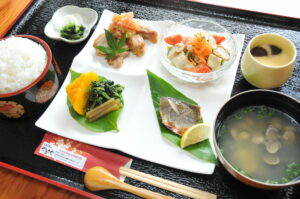
Yamasaya
Address〒692-0623
319 Fube, Hirose-cho, Yasugi-shiContact0854-36-0880
HolidayTuesdays (or the following day if Tuesday is a national holiday), Year-end and New Year holidays
Click here to read more

-
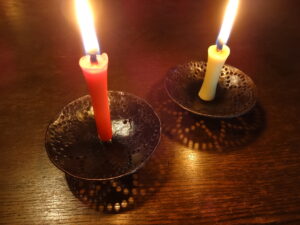
Blacksmith Workshop Hiromitsu
Address〒692-0623
1168-8 Nunobe, Hirose-cho, Yasugi-shiContact0854-36-0026
HolidayIrregular holidays
Click here to read more

-

strawberry farm kokoro
Address205 Hojishimacho, Yasugi City, Shimane Prefecture
Contact080-5616-2522
HolidayIrregular holidays
Strawberry picking period: Mid-March to early May *The timing may change depending on the year, so please check with the store.Click here to read more






